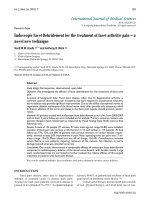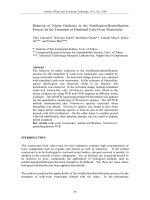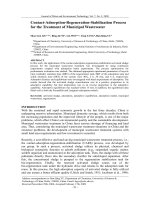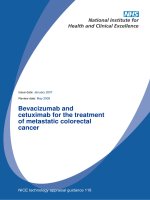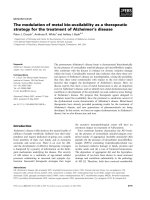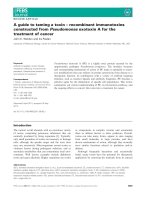JPR 27894 bupivacaine liposome injectable suspension for the treatment 081312
Bạn đang xem bản rút gọn của tài liệu. Xem và tải ngay bản đầy đủ của tài liệu tại đây (2.26 MB, 8 trang )
© 2012 Chahar and Cummings III, publisher and licensee Dove Medical Press Ltd. This is an Open Access
article which permits unrestricted noncommercial use, provided the original work is properly cited.
Journal of Pain Research 2012:5 257–264
Journal of Pain Research
Liposomal bupivacaine: a review of a new
bupivacaine formulation
Praveen Chahar
Kenneth C Cummings III
Anesthesiology Institute, Cleveland
Clinic Foundation, Cleveland,
Ohio, USA
Correspondence: Kenneth Cummings III
Cleveland Clinic Foundation, 9500 Euclid
Avenue, Mail code G30, Cleveland,
OH 44195, USA
Tel +1 216 444 1016
Fax +1 216 444 4383
Email
Abstract: Many attempts have been made to increase the duration of local anesthetic action. One
avenue of investigation has focused on encapsulating local anesthetics within carrier molecules
to increase their residence time at the site of action. This article aims to review the literature
surrounding the recently approved formulation of bupivacaine, which consists of bupivacaine
loaded in multivesicular liposomes. This preparation increases the duration of local anesthetic
action by slow release from the liposome and delays the peak plasma concentration when
compared to plain bupivacaine administration. Liposomal bupivacaine has been approved by
the US Food and Drug Administration for local infiltration for pain relief after bunionectomy
and hemorrhoidectomy. Studies have shown it to be an effective tool for postoperative pain
relief with opioid sparing effects and it has also been found to have an acceptable adverse
effect profile. Its kinetics are favorable even in patients with moderate hepatic impairment,
and it has been found not to delay wound healing after orthopedic surgery. More studies are
needed to establish its safety and efficacy for use via intrathecal, epidural, or perineural routes.
In conclusion, liposomal bupivacaine is effective for treating postoperative pain when used via
local infiltration when compared to placebo with a prolonged duration of action, predictable
kinetics, and an acceptable side effect profile. However, more adequately powered trials are
needed to establish its superiority over plain bupivacaine.
Keywords: liposomal bupivacaine, postoperative pain, pharmacokinetics, pharmacodynamics,
efficacy, safety
Introduction
Pain is a protective mechanism which has adaptive value, and the inability to experi-
ence pain has been linked to early mortality from accidental injuries or damage to
joints.
1,2
However, pain in the postoperative setting is an unwanted side effect of
surgery directed to improve morbidity or mortality. The potential benefits of optimal
postoperative pain control include: improved cardiac, respiratory, and gastrointestinal
functions; fewer thromboembolic complications; improved arterial graft survival;
fewer septic complications; reduced chronic post surgical pain; reduced mortality in
high-risk patients; and reduced health care costs.
3
Opioids have been the cornerstone
of relief for perioperative pain; however, opioids have numerous side effects includ-
ing nausea, vomiting, respiratory depression, prolonged ileus, itching, tolerance, and
development of opiate induced hyperalgesia.
4,5
Increasingly, multimodal analgesia is used to reduce perioperative opiate require-
ments, thus potentially reducing opioid side effects and improving the quality of
analgesia.
6,7
Local anesthetics are increasingly used perioperatively via different routes
Dovepress
submit your manuscript | www.dovepress.com
Dovepress
257
REVIEW
open access to scientific and medical research
Open Access Full Text Article
/>Number of times this article has been viewed
This article was published in the following Dove Press journal:
Journal of Pain Research
13 August 2012
Journal of Pain Research 2012:5
as part of a multimodal regimen.
8
The use of bolus injection
of local anesthetics is limited by duration of post operative
pain relief with the average duration of block via interscalene
injection being 8 to 12 hours with either bupivacaine 0.5% or
ropivacaine 0.5% or 0.75%.
9
Local anesthetic infusions via
catheters are used to increase the duration of postoperative
analgesia;
10
however, placement and maintenance of perineu-
ral catheters involves additional training
11
in addition to the
added cost of pumps.
12
Complications due to perineural catheters are infrequent
but can be life threatening, and these complications can
include infection, septicemia, intravascular placement, or
intravascular catheter migration.
13
The development of new,
long acting local anesthetics, like liposomal bupivacaine is
potentially important in the management of perioperative pain.
This article will review liposomal bupivacaine as a potential
addition to the clinician’s analgesic armamentarium.
Liposomal bupivacaine
Liposomes are microscopic structures consisting of a phospho-
lipid bilayer encapsulating an aqueous core. They may be unila-
mellar, multilamellar, or multivesicular. Unilamellar liposomes
Figure 1 Scanning electron microscope image of DepoFoam
®
containing bupivacaine.
Image supplied courtesy of Pacira Pharmaceuticals, Inc, 5 Sylvan Way, Parsippany, NJ 07054.
consist of a single lipid bilayer surrounding the aqueous core,
whereas multilamellar liposomes consist of concentric lipid
layers. Multivesicular liposomes (MVL), however, consist of
nonconcentric lipid bilayers. The nonconcentric nature of MVL
confers characteristic drug release patterns from the aqueous
core that are different from the unilamellar and multilamellar
liposomes, leading to increased stability and longer duration of
drug release. The release of drug from the MVL requires only a
breach in the external layer, and release of a drug from internal
vesicles leads to redistribution of the drug within the particle
without release. The multivesicular structure also ensures that
the vesicles rearrange themselves without release of drug by
internal fusion and division.
14,15
These vesicles can encapsu-
late water soluble drugs in their core, and lipid soluble drugs
within the membrane. They are used in the systemic delivery of
antifungals, antineoplastics, and antibiotics.
16,17
Currently avail-
able liposomal bupivacaine consists of vesicles of bupivacaine
loaded in the aqueous chambers using DepoFoam
®
technology
(Pacira Pharmaceuticals Inc, San Diego, CA). Each particle is
composed of a honeycomb like structure of numerous internal
aqueous chambers containing encapsulated bupivacaine
18,19
(Figures 1 and 2).
submit your manuscript | www.dovepress.com
Dovepress
Dovepress
258
Chahar and Cummings III
Journal of Pain Research 2012:5
Pharmacodynamics
Bupivacaine is an amide local anesthetic, which acts by inac-
tivating voltage-dependent sodium channels. It has a pKa of
8.1 so only 15% is present in uncharged form at tissue pH.
The uncharged fraction of bupivacaine travels across the cell
membrane of the nerve, and once charged binds to the inner
side of sodium channels, inactivating them.
20
The release of
bupivacaine from its binding site is slow, which leads to a
longer duration of action than lidocaine.
21
Pharmacokinetics
The pharmacokinetics of MVL bupivacaine have been
studied in both animal and human models. Richard et al
18
compared MVL bupivacaine in doses of 9, 18, and 30 mg/kg
with 9 mg/kg of plain bupivacaine injected by wound infil-
tration in rabbits. They found the C
max
to be dose depen-
dent, being 107 ± 27.6, 222 ± 28.3, and 307 ± 148 ng/mL
for the three doses of MVL bupivacaine, respectively.
However, the C
max
was much lower than plain bupivacaine
(620 ± 89.9 ng/mL). The plasma bupivacaine concentra-
tion in the group receiving plain bupivacaine peaked
quickly compared to the MVL bupivacaine group: 1 ± 0 h
compared to 12.5 ± 8.06, 7.0 ± 11.3, and 30.3 ± 22.5 hours
for the three doses of MVL bupivacaine, respectively.
Plasma bupivacaine concentrations were detectable in most
animals (dogs) who received MVL bupivacaine 9 mg/kg
over a 96-hour study period.
In the pharmacokinetic study of human volunteers,
Davidson et al
22
compared subcutaneous injection of 20 mL
of 2% liposomal bupivacaine versus 20 mL of 0.5% plain
bupivacaine. They found no difference in the C
max
between
the two groups (0.87 ± 0.45 versus 0.83 ± 0.34 in plain and
liposomal groups, respectively) despite a 4-fold increase
in bupivacaine dose and a 9.8-fold increase in the terminal
half-life displayed by the liposomal bupivacaine group
(131 ± 58 versus 1294 ± 860 min in plain and liposomal
groups, respectively). The T
max
increased seven-fold in
the liposomal bupivacaine group compared to the group
administered plain bupivacaine, which was attributable to
the slow release of liposomal bupivacaine. The attributes of
slow release leading to prolonged T
max
and long T ½ leading
to prolonged detectable plasma concentration of liposomal
bupivacaine have been confirmed in a subsequent Phase II,
multicenter clinical trial conducted by Langford et al.
23
Bupivacaine is metabolized mainly in the liver by
glucuronide conjugation and hepatic N-dealkylation into
pipecolylxylidine. Pipecolylxylidine is then hydroxylated
and forms glucuronide conjugates. A small amount of
bupivacaine is excreted unchanged in urine.
24
In a phar-
macokinetic study of liposomal bupivacaine in patients
with moderate hepatic impairment, Onel et al
25
found that
although bupivacaine and pipecolylxylidine concentrations
were higher in patients with moderate hepatic impairment
than in patients with normal hepatic function, the concentra-
tion time plots were similar in both groups, and the differ-
ences were small enough not to warrant dose adjustments
as per Food and Drug Administration (FDA) guidelines.
Efcacy in postoperative pain
Liposomal bupivacaine has been FDA approved for
single dose wound infiltration in postoperative pain
relief among patients undergoing hemorrhoidectomy and
bunionectomy.
26
Gorfine et al
27
conducted a multicenter,
randomized, double blind, placebo-controlled trial in patients
undergoing hemorrhoidectomy. At the end of surgery,
patients were randomized to receive either 300 mg (30 mL)
extended release MVL bupivacaine or placebo (30 mL
of 0.9% sodium chloride) in 5 mL increments via wound
infiltration. Intraoperative use of all analgesics or local
anesthetics, except fentanyl, was prohibited unless needed
for the treatment of adverse effects. Patients remained at the
DepoFoam
(non-concentric)
®
10–30μm
Figure 2 Cross-sectional diagram of DepoFoam containing bupivacaine.
Image supplied courtesy of Pacira Pharmaceuticals, Inc, 5 Sylvan Way, Parsippany,
NJ 07054.
submit your manuscript | www.dovepress.com
Dovepress
Dovepress
259
Review of liposomal bupivacaine
Journal of Pain Research 2012:5
study center for 72 hours, and were administered postsurgical
analgesia in response to breakthrough pain consisting of
morphine sulfate as needed.
The primary outcome measure consisted of a cumulative
pain score in the first 72 hours as reflected in the AUC
0–72
(area
under the curve) numerical rating score (NRS) of pain inten-
sity. Secondary efficacy measures consisted of assessing the
proportion of patients who received no opioid rescue medica-
tions, total amount of opioid rescue medications consumed,
time to first postsurgical use of rescue medications, and the
patient’s rating of satisfaction with postsurgical analgesia.
The researchers found the pain scores to be markedly lower
in the bupivacaine extended release group compared to
those receiving the placebo with a least mean square (SE)
AUC ranging from 0 to 72 hours of 141.8 (10.7) in the MVL
bupivacaine group versus 202.5 (10.7) in the placebo group
(P , 0.0001). In the bupivacaine extended release group,
59% of patients were opioid free at 12 hours, and 28% were
opioid free at 72 hours when compared to 14% and 10% in the
placebo group, respectively (P , 0.0008 through 72 hours).
In addition, the mean total amount of opioid consumed was
lower in the MVL bupivacaine group (22.3 mg vs 29.1 mg,
P # 0.0006), and the median time to first opioid use was
longer (14.3 hours vs 1.2 hours with P , 0.0001) and was
associated with greater patient satisfaction with postopera-
tive analgesia (95% vs 73%, P = 0.0007) when compared
to placebo.
Golf et al
28
conducted a multicenter, parallel group, pla-
cebo controlled, randomized, double blind study in which they
compared extended release MVL bupivacaine to placebo in
patients undergoing bunionectomy. The patients underwent
primary first metatarsal bunionectomy under midazolam and/
or propofol sedation with Mayo block with up to 25 mL of
2% lidocaine with epinephrine. Within 30 minutes after injec-
tion of lidocaine, the patients received either a single dose
of 120 mg (8 mL) extended release bupivacaine or placebo
(8 mL 0.9% sodium chloride) by local infiltration. Patients
were observed for 24 hours at the study center. Rescue anal-
gesia consisted of 5 mg oxycodone/325 mg acetaminophen
tablets up to a maximum of 12 tablets per day with a single
dose of intravenous ketorolac 15–30 mg as a second rescue.
The primary outcome measure was the AUC of NRS pain
scores through 24 hours. Secondary outcome measures
consisted of: the proportion of patients who received no
rescue pain medications; AUC of NRS pain scores through
36, 48, 60, and 72 hours; the proportion of patients who
were pain free during the observation period; the time to first
rescue medication use; and total oxycodone/acetaminophen
consumption through 24, 36, 48, 60, and 72 hours. The
researchers found markedly reduced pain intensity scores at
24 and 36 hours post injection in the MVL bupivacaine group
compared to placebo (P = 0.0005 and P = 0.0229 at 24 and
36 hours) with no difference at 48 hours (P = 0.1316). The
percentage of patients who were pain free showed a statisti-
cally significant difference at 2, 4, 8, and 48 hours only in
the MVL bupivacaine group (P , 0.05), with more patients
in the MVL bupivacaine group not receiving any rescue
pain medication through 24 hours only (P , 0.05). The
time to first opioid use was longer (7.2 hours vs 4.3 hours,
P , 0.0001), and fewer mean total number of oxycodone/
acetaminophen tablets were used through 24 hours (3.8 vs 4.7
tablets, P = 0.0077) in the MVL bupivacaine group compared
to the placebo group.
Smoot et al
29
conducted a randomized, multicenter,
double blind, parallel group, active control study comparing
MVL bupivacaine 300 mg to bupivacaine HCl 100 mg (bupi-
vacaine 0.5% with epinephrine 1:200,000) in patients under-
going bilateral cosmetic submuscular breast augmentation.
At the end of the surgical procedure, the patients received
either 300 mg of MVL bupivacaine or 100 mg of bupivacaine
HCl (with epinephrine) on each side, injected locally at the
breast implant pockets at the end of surgery. Postoperatively,
the patients received 1000 mg of acetaminophen three times
daily with rescue analgesia (oxycodone) for breakthrough
pain through 96 hours. The primary outcome measure was
the AUC of NRS pain scores through 72 hours. Secondary
outcomes consisted of cumulative pain scores at time points
other than 72 hours, proportion of patients not requiring
rescue analgesia, total amount of rescue opioid medication
consumed, and integrated rank assessment through multiple
time points.
The mean cumulative pain score (numeric rating score
with activity through 72 hours) was not significantly dif-
ferent in the two groups (441.5 in the MVL bupivacaine
group vs 468.2 in the bupivacaine HCl group, P = 0.3999).
The lack of a difference was attributed to a lack of statisti-
cal power. The NRS pain score with activity mean (SE)
was markedly lower in the MVL bupivacaine group at 8
and 12 hours [4.9 (0.41) and 5.6 (0.40)] compared with the
bupivacaine HCl group [6.7 (0.40) and 6.9 (0.37), P = 0.0016
and 0.0143, respectively]. The difference in mean (SE) pain
scores at rest was also lower in the MVL bupivacaine group
at 8 hours only compared to the bupivacaine HCl group
[3.5 (0.35) vs 5.0 (0.34) respectively (P = 0.027)]. The total
amount of postsurgical rescue opioid medication used at
24 and 48 hours was also lower in the MVL bupivacaine
submit your manuscript | www.dovepress.com
Dovepress
Dovepress
260
Chahar and Cummings III
Journal of Pain Research 2012:5
group compared to the bupivacaine HCl group (P = 0.0211
and 0.0459, respectively).
Bramlett et al
30
performed a randomized, double blind
study comparing wound infiltration of MVL bupivacaine
to bupivacaine HCl for postsurgical analgesia in total
knee arthroplasty. They compared 150 mg of bupivacaine
HCl (with 1:200,000 epinephrine) to MVL bupivacaine
in doses of 133 mg, 266 mg, 399 mg, and 532 mg. The
patients were between 18–75 years old and were classi-
fied as American Society of Anesthesiologists physical
status 1–3 patients undergoing unilateral knee replacement
under general anesthesia. For 24 hours prior to surgery, all
patients received 1000 mg of acetaminophen three times
daily. Intraoperatively, only intravenous fentanyl use was
permitted. The study medications were diluted in 60 mL of
0.9% saline and were injected via local infiltration in the
deep tissues, the capsulotomy incision, and the subcutaneous
tissues intraoperatively. Postoperatively, patients received a
single dose of a nonsteroidal anti-inflammatory drug paren-
tally with oral acetaminophen. For rescue analgesia, patient-
controlled intravenous morphine was used until patients could
be switched to oral oxycodone 5–10 mg every 4–6 hours once
oral intake was established. The primary outcome measure
was AUC of NRS pain scores with activity (NRS-A) through
day 4. Secondary outcome measures consisted of: AUC of
NRS-A through time points other than day 4; AUC of NRS
pain scores at rest (NRS-R); NRS-R and NRS-A scores at
each assessed time point; total consumption of opioid rescue
medications; total consumption of opioid medications; time
to resumption of daily activities; and provider’s satisfaction
with postoperative analgesia on day 8.
There was no difference between the groups for the
primary outcome measure of the mean AUC of NRS pain
scores with activity. The mean (SD) scores were 20.4 (3.9)
in the bupivacaine HCl group versus 19.1 (4.4), 18.8 (5.3),
19.5 (5.3), and 20.7 (5.4), in the MVL bupivacaine 532 mg,
399 mg, 266 mg, and 133 mg groups, respectively. There
was no detectable difference in the groups with regard to
mean numeric rating scale pain scores, total consumption of
rescue opioids, or the time to resumption of work or normal
daily activities (Table 1).
Boogaerts et al
31
compared 0.5% bupivacaine (with
1:200,000 epinephrine) with 0.5% liposomal bupivacaine
(a multilamellar formulation different from the clinically
available multivesicular DepoFoam) administered epidur-
ally for the management of postsurgical pain. The patients
were classified as American Society of Anesthesiologists
physical status 2 and 3 undergoing major abdominal surgery.
Table 1 Studies comparing the efcacy of MVL bupivacaine versus placebo or bupivacaine HCl
Author Type
of study
Comparison Surgery Primary outcome Results
Gorne
et al
27
RCT 300 mg DepoFoam
bupivacaine compared
with placebo
Hemorrhoidectomy AUC
0–72
of NRS
pain intensity scores
Least square mean (SE) AUC
0–72
141.8 (10.7)
in the DepoFoam bupivacaine (n = 94) group
compared to 202.5 (10.7) in placebo
(n = 93). P , 0.0001.
Golf
et al
28
RCT 120 mg DepoFoam
bupivacaine compared
with placebo
Bunionectomy AUC
0–24
of NRS
pain intensity scores
Least square mean (SE) AUC
0–24
123.936
(4.4854) in DepoFoam bupivacaine group
(n = 93) compared to 146.233 (4.5869) in
placebo (n = 92). P , 0.0005. 95% CI
of difference between DepoFoam
bupivacaine vs placebo -34.799 to -9.794.
Smoot
et al
29
RCT 600 mg DepoFoam
bupivacaine compared
with 200 mg bupivacaine
HCl with epinephrine
1:200,000
Submuscular
augmentation
mammoplasty
AUC
0–72
of NRS-A
pain intensity scores
Mean (SE) AUC
0–72
441.5 (23.6) in
DepoFoam bupivacaine group (n = 66)
and 468.2 (23.0) in bupivacaine HCl group
(n = 70). P = 0.3999.
Bramlett
et al
30
RCT Bupivacaine HCl 150 mg
(0.5%) with epinephrine
1:200,000 compared with
four doses of DepoFoam
bupivacaine (133, 266,
399, and 532 mg)
Total knee
arthroplasty
AUC
0–96
of NRS-A
pain intensity scores
Mean (SD) 20.7 (5.4), 19.5 (5.3), 18.8 (5.3),
and 19.1 (4.4) in DepoFoam bupivacaine
133 mg, 266 mg, 399 mg, and 532 mg groups
(n = 25, 24, 26, and 21, respectively) and
20.4 (3.9) in the bupivacaine HCl group
(n = 30). P value .0.05 in each DepoFoam
bupivacaine group compared to
bupivacaine HCl group.
Abbreviations: AUC, area under the curve; MVL, multivesicular liposomes; NRS, numerical rating score; NOS, not otherwise specied; NRS-A, numerical rating score with
activity; RCT, randomized clinical trial; SD, standard deviation; SE, standared error.
submit your manuscript | www.dovepress.com
Dovepress
Dovepress
261
Review of liposomal bupivacaine
Journal of Pain Research 2012:5
The epidural catheter was inserted with a test dose of bupiva-
caine (0.5% 3 mL) with epinephrine 1:200,000 given at the
time of insertion. Postoperatively, when patients experienced
pain after complete recovery of motor function, they received
a 10 mL bolus of either liposomal bupivacaine 0.5% or 10 mL
of plain bupivacaine 0.5% (with 1:200,000 epinephrine). The
researchers found no detectable difference in the time of onset
of analgesia (13.75 ±1.25 min in the plain bupivacaine group
versus 13.92 ± 1.58 min in the liposomal bupivacaine group),
though the duration of analgesia increased significantly in
the liposomal bupivacaine group (6.25 ± 1.13 hours in the
liposomal bupivacaine group versus 3.2 ± 0.4 hours in the
plain bupivacaine group, P , 0.05). In a subset of patients
who underwent abdominal aortic surgery, the duration of
analgesia was 10.6 ± 1.4 hours in the liposomal bupivacaine
group versus 2.42 ± 0.35 hours in the plain bupivacaine group
(P , 0.001). There was no motor block in the liposomal
bupivacaine group though intraoperative surgical anesthesia
was not observed with the liposomal bupivacaine group. The
lack of surgical block was thought to be due to alterations in
the pharmacodynamics of the drug preventing the necessary
amount of free bupivacaine available at the site of action,
thus producing only postsurgical analgesia. There are no
studies evaluating the epidural use of DepoFoam bupivacaine
to assess whether the lack of surgical analgesia is seen with
the DepoFoam formulation as well.
Safety
Bupivacaine may produce many adverse effects. The most
common life threatening side effects involve the cardiovas-
cular and central nervous systems.
32,33
Bupivacaine is more
cardiotoxic than lidocaine, and it produces its toxicity by
producing cardiac conduction block.
34
Animal studies have
shown that bupivacaine uncouples oxidative phosphoryla-
tion, may induce apoptosis in muscle cells, and may cause
Schwann cell damage. The damage to Schwann cells hap-
pens in both a time as well as a concentration dependent
fashion.
35
The myotoxicity of bupivacaine is well described
and may be related to Ca
2+
-induced apoptosis of muscle cells.
The myotoxicity of bupivacaine is most pronounced after
retrobulbar and peribulbar blocks with an overall incidence
of anesthesia-related diplopia reported to be 0.25%.
36,37
Although the diplopia may resolve spontaneously, it may
require surgical correction.
38
The most common side effects of MVL bupivacaine
in clinical trials included nausea, vomiting, constipa-
tion, pyrexia, dizziness, and headache.
28,30
Bergese et al
39
compared the cardiac safety of MVL bupivacaine in four
doses (150, 300, 450, or 600 mg) to bupivacaine HCl with
epinephrine injected via wound infiltration intraoperatively
in patients undergoing total knee arthroplasty. They found
no significant differences in change from baseline in QRS
or QTc duration in the two groups, nor did the two groups
differ in mean change from baseline heart rate and PR
interval. Naseem et al
40
examined the effect of four doses
of MVL bupivacaine (300, 450, 600, and 750 mg) injected
subcutaneously on the QTc interval in healthy volunteers.
None of the participants receiving MVL bupivacaine had a
maximum QTc interval greater than 500 ms, and there were
no changes in QTc of greater than 60 ms at any measured
time point.
In a 2-year follow up study assessing the effect of MVL
bupivacaine on the integrity of breast implants after aug-
mentation mammoplasty, Minowitz et al
41
found no negative
impact of intraoperative use of MVL bupivacaine on the
integrity of breast implants. Local anesthetics have inhibi-
tory effects on platelet aggregation in response to different
agonists. Pinto et al
42
studied the effect of multilamellar
liposomal local anesthetics on the inhibition of platelet aggre-
gation in response to adenosine diphosphate. They found that
encapsulation of local anesthetics into liposomes increased
the inhibitory effect of local anesthetics; however, the clinical
impact (if any) of this finding remains to be seen in larger
trials. In an animal studies by Richard et al
18,19
evaluating the
safety and efficacy of MVL bupivacaine compared to plain
bupivacaine and saline, the authors did find granulomatous
inflammation in the MVL bupivacaine group, which was
considered to be a normal reaction to liposomes; however,
there was no effect on wound healing. MVL bupivacaine
did not alter wound healing or wound scarring when used
for postsurgical analgesia after total knee arthroplasty in
humans.
30
DepoFoam
®
should not be coadministered with any other
local anesthetic as it may increase the release of bupivacaine
from the liposomes. It should not be allowed to come in
contact with antiseptics like chlorhexidine or povidine iodine
as they may disrupt the lipid layers leading to uncontrolled
release of bupivacaine.
43
Discussion
DepoFoam-encapsulated bupivacaine is a new formula-
tion of bupivacaine that provides slow sustained release of
bupivacaine from multivesicular liposomes. Compared to
placebo, it has been shown to produce prolonged analgesia
with an opioid sparing effect, although more adequately
powered trials are needed to assess its efficacy and duration of
submit your manuscript | www.dovepress.com
Dovepress
Dovepress
262
Chahar and Cummings III
Journal of Pain Research 2012:5
analgesia compared to standard local anesthetic solutions. At
present, it is approved by the FDA for use via local infiltration
after bunionectomy and hemorrhoidectomy. It has not been
shown to be more toxic compared to plain bupivacaine, and
it does not have markedly different cardiac effects than plain
bupivacaine. It appears safe for use in patients with moderate
hepatic impairment and does not warrant dose adjustment in
that group.
25
It has not been evaluated for use via intrathe-
cal, epidural, or perineural administration or in pediatric
and pregnant patients.
43
More multicenter trials are needed
to evaluate its efficacy and safety in these populations. If its
safety and efficacy are established for epidural, intrathecal,
and perineural use, it holds a potentially valuable place in
the analgesic arsenal for use against postoperative pain and
may substantially reduce the cost and complications associ-
ated with catheter and local anesthetic infusion pumps. In
addition, the opioid sparing effects of MVL bupivacaine are
valuable in potentially reducing opioid-related side effects.
This in turn may reduce unwanted hospital admissions related
to postoperative pain or opioid side effects.
In summary, the current literature studying MVL bupiva-
caine has, in general, demonstrated prolonged analgesia and
reduced opioid side effects compared to placebo. However, its
increased analgesic efficacy (and cost effectiveness) compared
to plain bupivacaine in various clinical settings needs to be
evaluated in adequately powered clinical trials. At present, the
literature supports only a limited role for MVL bupivacaine.
This may change as larger studies are conducted.
Acknowledgements
Figure 1 and a copy of References 23, 25, 39, and 40 were
provided by Pacira Pharmaceuticals, Inc, 5 Sylvan Way,
Parsippany, NJ 07054. The company had no input in the
preparation or editing of this manuscript.
Disclosure
The authors report no conflicts of interest in this work.
References
1. Acerbi A, Parisi D. The evolution of pain. In: Costa FA, Rocha LM,
Costa E, Harvey I, Coutinho A, editors. Advances in Artificial Life. ECAL
2007: Proceedings of the 9th Annual Conference on Advances in Artificial
Life; September 10–14, 2007; Lisbon, Portugal. Berlin: Springer; 2007:
816–824.
2. Loeser JD, Melzack R. Pain: an overview. Lancet. 1999;353(9164):
1607–1069.
3. Breivik H. Pain management. Baillieres Clin Anaesthesiol. 1994;8(4):
775–795.
4. Koppert W, Schmelz M. The impact of opioid-induced hyperal-
gesia for postoperative pain. Best Pract Res Clin Anaesthesiol.
2007;21(1):65–83.
5. Chau DL, Walker V, Pai L, Cho LM. Opiates and elderly: use and side
effects. Clin Interv Aging. 2008;3(2):273–278.
6. Buvanendran A, Kroin JS. Multimodal analgesia for controlling acute
postoperative pain. Curr Opin Anaesthesiol. 2009;22(5):588–593.
7. Dahl V, Raeder JC. Non-opioid postoperative analgesia. Acta
Anaesthesiol Scand. 2000;44(10):1191–1203.
8. Tuncer S, Aysolmaz G, Reisli R, Erol A, Yalçin N, Yosunkaya A. The
effects of the administration of subfacial levobupivacaine infusion with
the ON-Q pain pump system on postoperative analgesia and tramadol
consumption in cesarean operations. Agri. 2010;22(2):73–78.
9. Borgeat A, Ekatodramis G. Anaesthesia for shoulder surgery. Best Pract
Res Clin Anaesthesiol. 2002;16(2):211–225.
10. Osada R, Zukawa M, Seki E, Kimura T. Continuous peripheral
nerve block in forearm for severe hand trauma. Hand Surg.
2011;16(3):239–244.
11. Chelly JE, Delaunay L, Williams B, Borghi B. Outpatient lower
extremity infusions. Best Pract Res Clin Anaesthesiol. 2002;16(2):
311–320.
12. Richman JM, Liu SS, Courpas G, et al. Does continuous peripheral
nerve block provide superior pain control to opioids? A meta-analysis.
Anesth Analg. 2006;102(1):248–257.
13. Chelly JE, Ghisi D, Fanelli A. Continuous peripheral nerve blocks in
acute pain management. Br J Anaesth. 2010;105 Suppl 1:i86–i96.
14. Mantripragada S. A lipid based depot (DepoFoam technology)
for sustained release drug delivery. Prog Lipid Res. 2002;41(5):
392–406.
15. New RRC. Influence of liposome characteristics on their properties and
fate. In: Philippot JR, Schuber F, editors. Liposomes as Tools in Basic
Research and Industry. Boca Raton: CRC Press; 1995:3–20.
16. Mowat JJ, Mok MJ, MacLeod BA, Madden TD. Liposomal
bupivacaine. Extended duration nerve blockade using large unilamel-
lar vesicles that exhibit a proton gradient. Anesthesiology. 1996;85(3):
635–643.
17. Ostro MJ, Cullis PR. Use of liposomes as injectable-drug delivery
systems. Am J Hosp Pharm. 1989;46(8):1576–1587.
18. Richard BM, Ott LR, Haan D, et al. The safety and tolerability evalua-
tion of DepoFoam bupivacaine (bupivacaine extended-release liposome
injection) administered by incision wound infiltration in rabbits and
dogs. Expert Opin Investig Drugs. 2011;20(10):1327–1341.
19. Richard BM, Newton P, Ott LR, et al. The safety of EXPAREL
®
(bupivacaine liposome injectable suspension) administered by periph-
eral nerve block in rabbits and dogs. J Drug Deliv [Serial on the
Internet]. Jan 2012 [cited July 2, 2012];962101:[10 p.]. http://www.
hindawi.com/journals/jdd/2012/962101/. Accessed July 2, 2012.
20. Dullenkopf A, Borgeat A. Local anesthetics. Differences and similarities
in the “-cains”. Anaesthesist. 2003;52(4):329–340.
21. Covino BG. Pharmacology of local anaesthetic agents. Br J Anaesth.
1986;58(7):701–716.
22. Davidson EM, Barenholz Y, Cohen R, Haroutiunian S, Kagan L,
Ginosar Y. High-dose bupivacaine remotely loaded into multivesicular
liposomes demonstrates slow drug release without systemic toxic
plasma concentrations after subcutaneous administration in humans.
Anesth Analg. 2010;110(4):1018–1023.
23. Langford RM, Chappell GM, Karrasch JA. A single administration of
DepoBupivacaine (TM) intraoperatively results in prolonged detectable
plasma bupivacaine and analgesia in patients undergoing inguinal hernia
repair. Poster presented at: 62nd Annual Postgraduate Assembly of the
New York State Society of Anesthesiologists; December 12–16, 2008;
New York, NY.
24. Gantenbein M, Attolini L, Bruguerolle B, et al. Oxidative metabolism
of bupivacaine into pipecolylxylidine in humans is mainly catalyzed
by CYP3A. Drug Metab Dispos. 2000;28(4):383–385.
25. Onel E, Warnott K, Lambert W, Patou G. Pharmacokinetics of depobupi-
vacaine (EXPAREL
TM
), a novel bupivacaine extended release liposomal
injection, in volunteers with moderate hepatic impairment. Poster pre-
sented at: 112th Annual Meeting of the American Society of Clinical
Pharmacology and Therapeutics; March 3–6, 2011; Dallas, TX.
submit your manuscript | www.dovepress.com
Dovepress
Dovepress
263
Review of liposomal bupivacaine
Journal of Pain Research
Publish your work in this journal
Submit your manuscript here: />The Journal of Pain Research is an international, peer-reviewed, open
access, online journal that welcomes laboratory and clinical findings
in the fields of pain research and the prevention and management
of pain. Original research, reviews, symposium reports, hypoth-
esis formation and commentaries are all considered for publication.
The manuscript management system is completely online and includes
a very quick and fair peer-review system, which is all easy to use. Visit
to read real quotes from
published authors.
Journal of Pain Research 2012:5
26. US Food and Drug Administration. FDA Label Approved on 10/28/2011
(PDF) for EXPAREL. US Silver Spring, MD: US Food and Drug Admin-
istration. Available from: />docs/label/2011/022496s000lbl.pdf. Accessed May 01, 2012.
27. Gorf ine SR, Onel E, Patou G, Krivokapic ZV. Bupivacaine
extended-release liposome injection for prolonged postsurgical
analgesia in patients undergoing hemorrhoidectomy: a multicenter,
randomized, double-blind, placebo-controlled trial. Dis Colon Rectum.
2011;54(12):1552–1559.
28. Golf M, Daniels SE, Onel E. A phase 3, randomized, placebo-controlled
trial of DepoFoam
®
bupivacaine (extended-release bupivacaine local
analgesic) in bunionectomy. Adv Ther. 2011;28(9):776–788.
29. Smoot JD, Bergese SD, Onel E, Williams HT, Hedden W. The efficacy
and safety of DepoFoam bupivacaine in patients undergoing bilateral,
cosmetic, submuscular augmentation mammoplasty: a randomized,
double-blind, active-control study. Aesthet Surg J. 2012;32(1):69–76.
30. Bramlett K, Onel E, Viscusi ER, Jones K. A randomized, double-
blind, dose-ranging study comparing wound infiltration of DepoFoam
bupivacaine, an extended-release liposomal bupivacaine, to bupivacaine
HCl for postsurgical analgesia in total knee arthroplasty. Knee. In press:
January 27, 2012.
31. Boogaerts JG, Lafont ND, Declercq AG, et al. Epidural administration
of liposome-associated bupivacaine for the management of postsurgical
pain: a first study. J Clin Anesth. 1994;6(4):315–320.
32. AstraZeneca Canada. Bupivacaine Prescribing Information.
Mississauga, ON: AstraZeneca Canada Inc. Available from: http://
www.astrazeneca.ca/documents/ProductPortfolio/SENSORCAINE_
PM_en.pdf. Accessed April 28, 2012.
33. Tucker GT, Mather LE. Clinical pharmacokinetics of local anaesthetics.
Clin Pharmacokinet. 1979;4(4):241–278.
34. Wolfe JW, Butterworth JF. Local anesthetic systemic toxicity:
update on mechanisms and treatment. Curr Opin Anaesthesiol.
2011;24(5):561–566.
35. Yang S, Abrahams MS, Hurn PD, Grafe MR, Kirsch JR. Local anesthetic
Schwann cell toxicity is time and concentration dependent. Reg Anesth
Pain Med. 2011;36(5):444–451.
36. Zink W, Graf BM. Local anesthetic myotoxicity. Reg Anesth Pain Med.
2004;29(4):333–340.
37. Gómez-Arnau JI, Yangüela J, González A, et al. Anaesthesia-related
diplopia after cataract surgery. Br J Anaesth. 2003;90(2):189–193.
38. Vlăduţiu C, Sevan S, Ciuică M. Diplopia through toxic myopathy after
cataract surgery. Oftalmologia. 2008;52(4):77–82.
39. Bergese SD, Onel E, Morren M, Morganroth J. Bupivacaine extended-
release liposome injection exhibits a favorable cardiac safety profile.
Reg Anesth Pain Med. 2012;37(2):145–151.
40. Naseem A, Harada T, Wang D, et al. Bupivacaine extended release lipo-
some injection does not prolong QTc interval in a thorough QT/QTc study
in healthy volunteers. J Clin Pharmacol. Epub November 4, 2011.
41. Minkowitz HS, Onel E, Patronella CK, Smoot JD. A two-year
observational study assessing the safety of DepoFoam bupivacaine after
augmentation mammaplasty. Aesthet Surg J. 2012;32(2):186–193.
42. Pinto LM, Pereira R, de Paula E, de Nucci G, Santana MH, Donato JL.
Influence of liposomal local anesthetics on platelet aggregation in vitro.
J Liposome Res. 2004;14(1–2):51–59.
43. Pacira Pharmaceuticals, Inc. Exparel (Bupivacaine Liposome
Injectable Suspension) Product Monograph. Parsippany, NJ: Pacira
Pharmaceuticals, Inc. Available from: />Exparel_Monograph.pdf. Accessed May 01, 2012.
submit your manuscript | www.dovepress.com
Dovepress
Dovepress
Dovepress
264
Chahar and Cummings III
